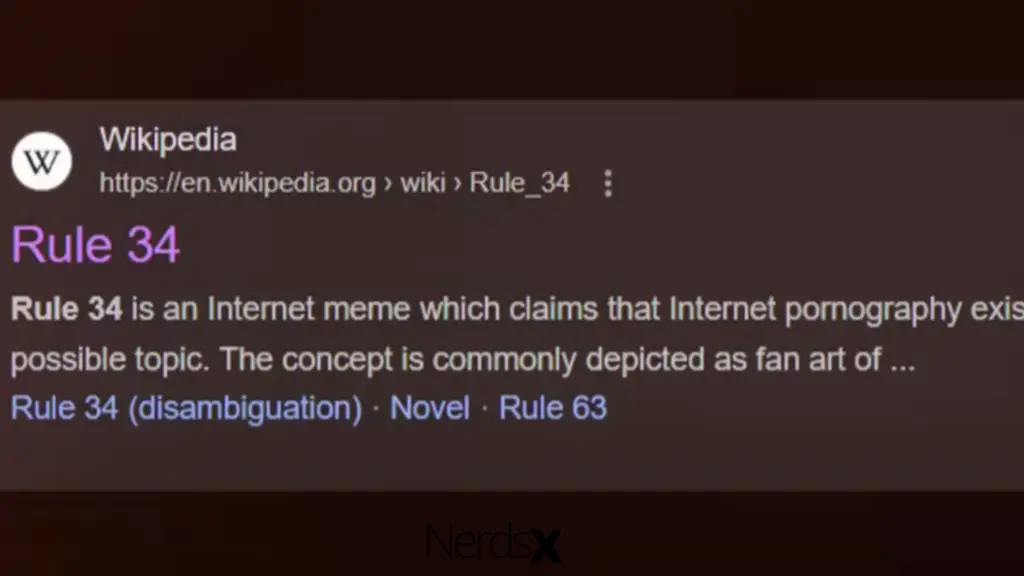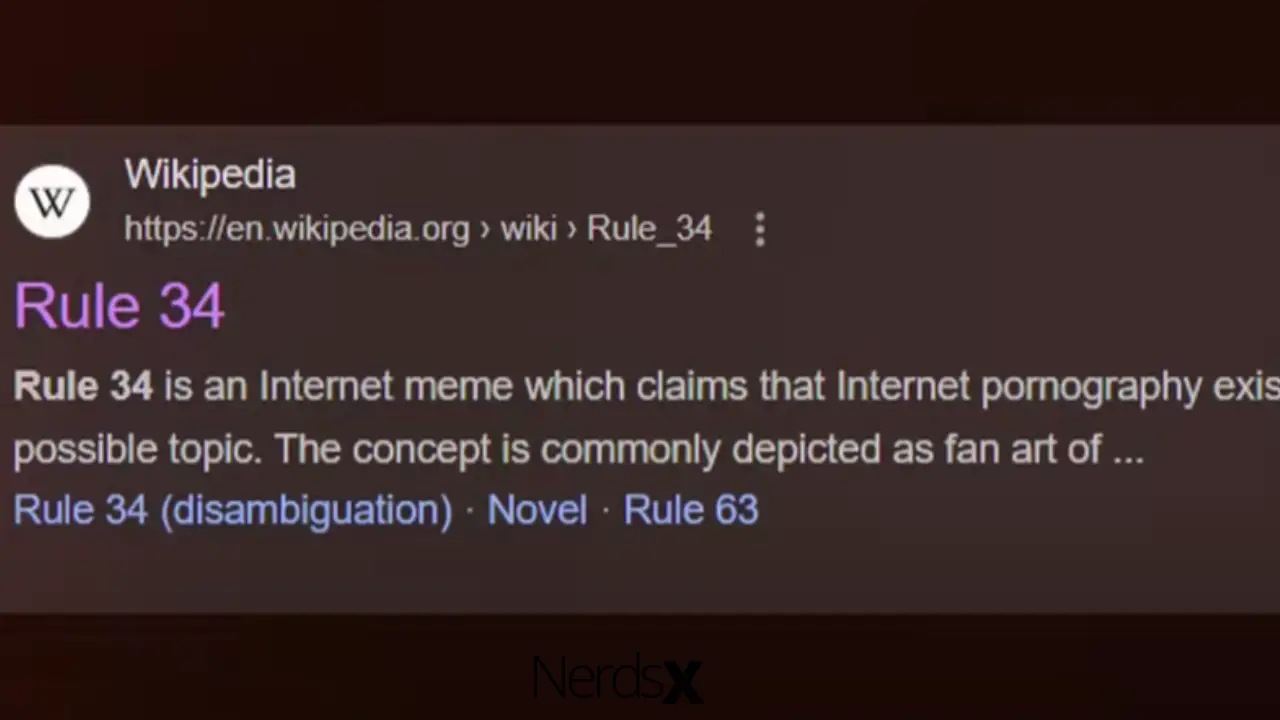Do you know that there are at least 77 rules of the Internet? 4chan’s “Rules of the Internet” are an informal collection of laws and maxims. Depending on who you ask, the rules are either not supposed to be taken seriously or are a solemn business. Most of them don’t apply outside of the group they came from, and the list is constantly evolving, but a few have become well-known thanks to Memetic Mutation. In this article, we discuss a mid-rule—rule number 34.
What Is Rule 34 Of The Internet?
I apologize if you’ve never heard of Rule 34. You’re about to have your innocence ruined. Rule 34 is an internet notion that asserts that if anything occurs in real life, can be thought about, or is made up; there is a p**nographic depiction. No exceptions are made to this rule. This includes cartoons, celebrities, and objects, and in some cases, these images go well beyond what we see in mainstream p**nography.
Rule 34 was the first Internet maxim that was unanimously acceptable. It is so well-founded and documented with expertized facts that even persons with minimal Internet expertise are aware of its name even if they are unaware of it. In many situations of Rule 34, internet users make sexual fantasies out of their favorite cartoon or animated characters. ‘Fan art’ is a term used to describe this type of work.�?
Funny enough, there’s also Rule 35, which states that if there aren’t any p**nographic depictions of something now, there will be in the future. This rule implies that if you discover you can’t find p**n of anything and point it out, someone will be pleased to draw/write/find it for you in a reasonable amount of time, only to keep Rule 34’s infallibility alive.
The Origin Of Rule 34
Rule 34 has its basis on a webcomic from 2003 titled “34th Rule There’s�?p**n�?of it, no exceptions “, which Peter Morley-Souter drew to express his surprise at witnessing Calvin and Hobbes parody p**n. “Calvin and Hobbes?” says the webcomic’s author, who is sitting at his computer with a startled expression on his face.�? Although Peter Morley’s comic strip image got forgotten quickly, the text became an instant hit on the Internet. The rule phrase has been transformed into several syntax variants and even used as a verb.
The notion of Rule #34 got highly popularized through 4Chan’s notoriously mischievous backwaters, where pranksters have had endless amusement with the topic since approximately 2000. Before it was banned, a single thread from 2008 documented over 365 user-submitted variants on Rule 34.

How Correct Is Rule 34?
It is 13 years since�?a British teenager coined “Rule 34.” The internet consumption patterns and the online p**n industry have altered.�? �?The weirdest�?sex acts�?may still exist somewhere in the unfathomable depths of the Internet, but it’s not on the surface like it used to be; you have to dig deeper.
“I believe we’re seeing the end of Rule 34,” says Ogi Ogas, a Harvard computational neuroscientist and author of the first large-scale research on Internet p**nography. “If you’re looking for it, it’s out there. But it’s no longer simple.”
In 2009 and 2010, Ogas performed his research, which included a review of more than 55 million p**nographic searches, during the tail end of what may be reminisced as the golden age of Rule 34.�?
The p**nographic industry, like the conventional media at the time, was undergoing massive changes as a result of the Internet.�?
Personal computers and improved Internet connections emancipated consumers from the unpleasantness of conversing with a curious mail carrier or the cyber cafe guy, allowing them to track down any erotic fiction they desired. Anyone with a WiFi connection and a willing audience could make it due to the same technology powering this fantastic new stuff called “Weblogs.”
Unfortunately, there are few excellent censuses of p**n sites during this period: Even Ogas’ study focused on what consumers sought rather than what they found.�?
However, some early “internet p**n” researchers noted a growing constellation of more specialized sites centered on every possible sexual identity and interest: In 2007, one set of researchers stated, “No theme is far enough away.” “There is nothing to be deemed as an exotic fetish.”�?
These studies all point at echoing what rule 34 is all about; since 2010, the internet p**nographic business has begun to consolidate, moving away from individual producers and distributors and toward big, crowdsourced aggregators known as “tube sites.” Tube sites funnel the great bulk of online p**n traffic, accounting for around 4.7 percent of desktop Internet traffic.
The usage of internet p**nography has been subject to extensive study. These have shown some intriguing data concerning the consumption of p**nographic material:
1. 40 million individuals in the United States frequent p**nographic websites regularly.
2. 10% of adults in the United States confess to being addicted to internet p**nography.
3. 17% of all women have a problem with p**nography.
4. 20% of men and 13% of women at work confess to seeing p**n.
5. 70% of women confess to keeping their online activity hidden.
6. A woman accounts for 1 out of every 3 visitors to p**nographic websites.
The fact that tube sites concentrate power and influence in the hands of a single firm – something that most casual users are unaware of – is equally devastating from a Rule 34 standpoint.�?
MindGeek owns eight of the top ten tube sites, including p**nhub, RedTube, and Youp**n. By utilizing its vast, centralized troves of material and user browsing data, it has controlled which types of p**nography become and stay popular. For example, most tube sites encourage and advocate particular tags, which influences how we talk about sex. They also make decisions about what information to promote and what to ignore.�?
p**nhub provides personalized content suggestions based on an algorithm. This curation tends to smooth out any oddities or eccentricities�?that individuals may bring to it, on top of its filtered homepage, which is accessed by almost 30 million people each month, and its well-strategized media and social-media presences.�?
Corey Price, p**nhub’s vice president, disputed that tube sites were involved in regulating or mainstreaming internet p**nography in a statement: p**nhub, in particular, is “democratizing the distribution of adult video material as YouTube did with mainstream video content,” he claimed.
However, the minimal evidence we have at this time shows otherwise.�?
A group of five French academics from various universities scraped the information – including tags defining content – of 1.7 million movies on the well-known tube sites’ Xnxx’ and ‘xHamster’ during one of the most recent quantitative assessments of internet p**n. They discovered that, despite a wide range of technically available material, just 5% of the sites’ available tags cover 90% of the videos.
On the other hand, the quote-unquote innovative material gets located in backwaters that are too obscure to find even with a Google search. Otherwise, it could have seemed as if Rule 34 had released a deluge of previously untapped sexual expression. Rule 34’s supporters, on the other hand, were primarily experimenting.
Where Do We Draw The Line When It Gets To Rule 34?
Speculative fiction has a lot to say about sex and much more to contribute to the debate. It’s the ideal location to examine alternate perspectives on sex since it’s a literature of ideas and possibilities—non-Western, non-patriarchal, even fanciful, or extraterrestrial.�?
In a nutshell, science fiction and fantasy require sex since they aren’t actually about aliens, monsters, or fantastical beings. Everything comes down to people. People also have a strong desire for sex and spend a lot of time thinking about it, at least twenty times every day.
Some people get drawn to the prohibited. Sexual taboos are a big turn-on for some. As a result, cartoon characters Mickey and Minnie Mouse or Abby Cadabby and Elmo have made animated p**n.�?
Nevertheless, my modification to Rule 34 is: It’s okay to sexualize fictional characters, not actual people. That is obscene and demeaning.�?
In 2008 after Presidential Candidate John McCain announced that Governor Sarah Palin would be his running mate, a�?post came up; an internet user posted a picture of Palin alongside the simple phrase, “Rule 34.”�?
In the days that followed, dozens, if not hundreds, of people expressed a desire to find or make p**nographic photographs of the undeniably attractive Governor. Pictures of Palin in different compromising poses began to appear on the site less than a day after the original call.�?
Whereas these photos received a lot of attention, the behaviors on 4chan were even more devious and obscene. Nude images, such as those used in Sarah Palin’s Rule 34 game, would have destroyed her political career; yet, such photos may cause some damage if the wrong people viewed them. Palin’s prospects would be less bright if the email account had more damaging information. However, both of these problems are part of a new world in which the sadism of a few internet-savvy teenagers may have a global impact in a matter of hours.
Conclusion
Rule 34 thrives because humans like having sex and watching others have sex. p**n is, in some ways, a type of escapism. Watching p**n releases dopamine in our brains, which provides us pleasure. However, people should avoid photoshopping images of real people to create sexual content. That is cyberbullying, which is against the law and basic human dignity.

